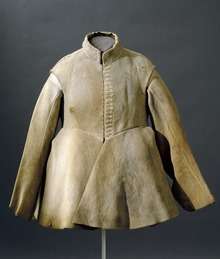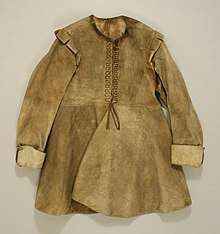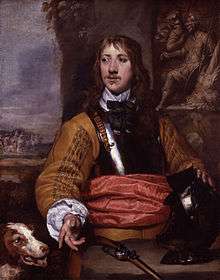Buff coat
The European buff coat (the term deriving from the ox or buffalo hide from which it was commonly made and its yellowish colour[1]) was an item of leather clothing worn by cavalry and officers during the 17th century, it also saw limited use by some infantry. It was often worn under armour. It was derived from the simple leather jerkins worn by huntsmen and soldiers during the Tudor period, these in turn deriving from the arming doublet worn under full plate armour.[2]

Production, appearance and variation


Buff coats were made in sleeveless and sleeved variants and were garments typically crafted from cowhide or buffalo hide. The very finest buff coats were made of the hide of the European elk.[3] Buff leather was produced by a method of "oil tanning"; following treatment with lime the hide was scraped to remove the outer layer, which gave the finished product a matt surface. The hide then had cod oil worked into it in a process called "kicking" and was finally air-dried. The oiling and drying steps could be repeated. The finished leather attained its characteristic buff colour and was supple, durable and weather resistant.[4]
Due to the thickness of the leather, the seams of these coats were all butt-jointed, with hidden or partially hidden stitches. Extant examples are lined, either with coarse linen or silk. Many high quality examples show apparent fastenings of gold or silver tape at the front, however, these were merely decorative, the real fastenings being hidden hooks and eyes attached to the inside of the join.[5] The extant collection of buff coats preserved at Littlecote House dating to 1649–1660, contains examples with leather varying from 0.06 to 0.22 inches (1.5 to 5.6 mm) in thickness and entire coats weighing between 4 lb 4 oz and 7 lb 8 oz (1.9–3.4 kg).[6]
All buff coats had deep skirts attached, which protected the upper legs of the wearer. Most surviving examples have sleeves, but a minority are sleeveless. Sleeves could be of a single thickness of leather from shoulder to wrist, or alternatively of a double thickness from the shoulder to the elbow, with a single thickness, to allow freedom of movement, to the wrist. Some of the highest quality buff coats, typically shown in portraits of officers, had multiple stripes of gold or silver lace running lengthwise down, or hooped around, the sleeves. [7][8]
Use
The coat provided some protection against cuts by swords and other edged weapons; however the buff coat was ineffective against the thrust; it was also ineffective as a protection from firearms, possibly excepting spent bullets. The buff coat was often worn under the plate armour cuirass, where it helped to cushion the wearer from chafing or bruising by the armour's edges. It was also worn on its own, as the buff coat was much more comfortable to wear for long periods of time than the cuirass. The finest quality buff coats were expensive, often much more so than the munition armour cuirasses typically issued to common soldiers, which may account for their widespread association with officers and other men of greater than average wealth.[9][10]
Together with the lobster-tailed pot helmet and cuirass it formed the basis of the equipment of the harquebusier, the typical type of cavalryman of the English Civil War and other European conflicts of the 17th century. Buff coats were issued to a minority of musketeers in the pike and shot formations to give them some protection during hand-to-hand combat. The buff coat was also worn by civilians requiring a protective and durable garment, such as huntsmen and men travelling on horseback.[11]
See also
References
- "Buff definition and meaning". Collins English Dictionary. Retrieved 2018-09-11.
- Tincey (1990), p. 15
- Brzezinski, p. 12
- Tincey (2002), p. 59
- Blackmore, pp. 19, 22
- Tincey (2002), p. 60
- Haythornthwaite, pp. 25, 37
- Blackmore, pp. 22–23
- Blackmore, pp. 18-19
- Tincey (2002), p, 18
- Haythornthwaite, pp. 25, 45
Bibliography
- Blackmore, D. (1990) Arms & Armour of the English Civil Wars, Trustees of the Royal Armouries. ISBN 0-948092-08-4
- Brzezinski, R. (Hook, R. - illustrator) (1993) The Army of Gustavus Adolphus (2) Cavalry. Osprey Publishing, ISBN 1-85532-350-8
- Haythornthwaite, P. (1983) The English Civil War, An Illustrated History Blandford Press. ISBN 1-85409-323-1.
- Tincey, J. (McBride, A. - illustrator) (1990) Soldiers of the English Civil War (2) Cavalry, Osprey Publishing, ISBN 0-85045-940-0
- Tincey, J. (Turner, G. - illustrator) (2002) Ironsides: English cavalry, 1588-1688, Osprey Publishing ISBN 1-84176-213-X
External links
![]()